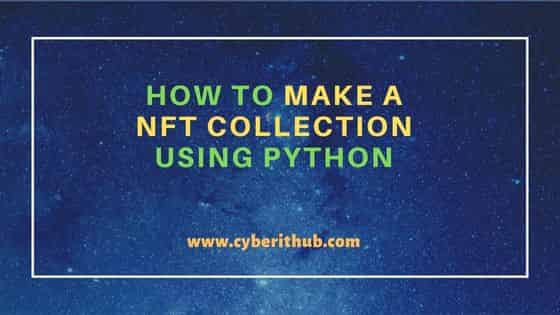Table of Contents
Non-fungible tokens (NFTs) are all the rage these days. However, if you’re an artist, or just a regular person, and you want to make your own NFT art, then you have some work ahead of you! One of the most important things you need is to be able to make a collection of NFTs.
Non-fungible tokens (NFTs) have become more prevalent in the world of cryptocurrency, but how do you create an NFT collection using Python? NFTs are an example of a crypto collectible - unique assets that can be owned and transferred on a blockchain. NFTs are usually implemented using a token standard known as ERC-721. You can build your own ERC-721 collection using Python.
What is an NFT ?

BAYC, the most popular NFT collection in the world / Source: Unsplash
Non-fungible tokens (NFTs) are unique cryptographic digital assets that exist on a blockchain and cannot be replicated. NFTs can represent real-world items like artwork and real estate. By using the blockchain to create immutable records, buyers and sellers can exchange goods more efficiently whilst reducing the possibility of fraud.
How are NFTs related to the cryptocurrency market ?
Most people are quick to judge NFTs and label them as a typical "crypto" product. But apart from flipping NFTs (which is done by some), it doesn't have much in common with trading, where you can buy Bitcoin and later sell it or use Bitcoins to purchase goods.
Instead, people who buy NFTs become collectors who can then either sell at a profit or exhibit their collections.
Why do people create NFTs ?
People create NFTs for multiple reasons. Some of them want to become more popular in the crypto space. Others want to make a profit. However, most people use NFTs as a kickstarter campaign that can help them raise money for a big project - like a video game or an exhibition in an art gallery. By creating an NFT, they are able to reach a larger audience and potentially secure funding that they may not have otherwise had access to. This makes NFTs a powerful tool for creatives and entrepreneurs looking to bring their ideas to life.
How to create a NFT using Python ?
Creating an NFT is not a hard task, but it does take time. What you need to have is a clear concept in mind, and some technical skills. In this paragraph, we'll show you how to create an NFT collection.
The first step is to develop a clear concept for your collection. What are you trying to communicate with your NFTs? What story do you want to tell? Once you have a concept in mind, it's time to start designing your NFTs.
Assign traits
Your NFTs should have traits. Usually, when designing an NFT, there are a couple of traits, like face, hair, nose, mouth, etc. This will determine the total number of NFTs that you will have in your collection. Let’s see a basic NFT collection.
face = ["White", "Blue", "Green"] face_weights = [45, 25,15] hair= ["Blonde", "Bald", "Brown", "Red"] hair_weights = [17, 16, 50, 17] nose = ["Big", "Small"] nose_weights = [30, 70]
What does that mean? There will be 3 traits for each image: face, hair, and nose. The weights are the proximity of each combination happening.
Let’s see the most common and the least common variations.
The most common is a white face, brown hair, and a small nose.
| Chance of happening = 45% X 50% X 70% = 0.45 = 0.1575 (or 15.75%). |
The least common is a green face, bald hair, and big nose.
| Chance of happening = 15% X 16% X 30% = 0.0072 (or 0.72%). |
Number of unique combinations
## Generate Traits
TOTAL_IMAGES = 150 # Number of random unique images we want to generate
all_images = []
# A recursive function to generate unique image combinations
def create_new_image():
new_image = {} #
# For each trait category, select a random trait based on the weightings
new_image ["Face"] = random.choices(face, face_weights)[0]
new_image ["Hair"] = random.choices(hair, hair_weights)[0]
new_image ["Nose"] = random.choices(nose, nose_weights)[0]
if new_image in all_images:
return create_new_image()
else:
return new_image
# Generate the unique combinations based on trait weightings
for i in range(TOTAL_IMAGES):
new_trait_image = create_new_image()
all_images.append(new_trait_image)
What is the number of unique combinations ?
The number of unique combinations is easy to define. Let's see how it is done.
Unique combinations = Trait 1 Variants X Trait 2 Variants X Trait 3 Variants
In our case, it will be the following:-
| 3 X 4 X 2 = 24 UNIQUE COMBINATIONS |
Of course, if you wish to make a big collection, we advise you to add more traits and more combinations.
Validation
Now, you should validate your NFTs. Let’s see how it’s done.
# Returns true if all images are unique def all_images_unique(all_images): seen = list() return not any(i in seen or seen.append(i) for i in all_images) print("Are all images unique?", all_images_unique(all_images)) # Add token Id to each image i = 0 for item in all_images: item["tokenId"] = i i = i + 1 print(all_images)
Final words
Creating and validating NFTs is not a hard task. Still, it requires some coding skills, but with the help of some guides like BetterProgramming, you might better understand how it’s done.

